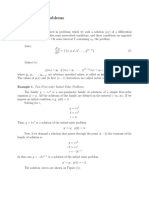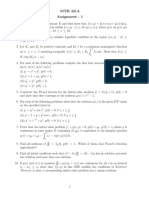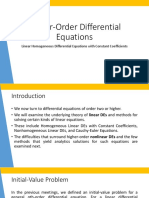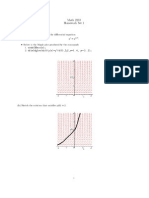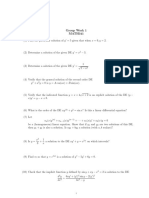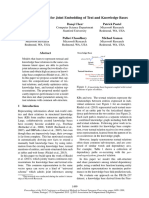ASSIGNMENT - 4 (Numerical Solution of Ordinary Differential Equations) Course: MCSC 202
Uploaded by
Rojan PradhanASSIGNMENT - 4 (Numerical Solution of Ordinary Differential Equations) Course: MCSC 202
Uploaded by
Rojan PradhanIssue Date: Due Date: One week from the issue date
——————————————————————————————————————————–
ASSIGNMENT - 4(Numerical Solution of Ordinary Differential Equations)
Course: MCSC 202
Problem 1 Consider the initial boundary value problem:
dy
= f (x, y), y(x0 ) = y0 (1)
dx
Derive a formula due to Euler Method and Modified Euler Method to find the solution of IVP (1). Use
Euler and Modified Euler method to find the solution of the initial value problem
dy y−x
= , y(0) = 1
dx y+x
for x = 0.1 with step size h = 0.02.
dy
Problem 2 Discuss Taylor series method to find the solution of initial value problem (1). Solve dx =
x + y, y(1) = 0 numerically upto x = 1.2 with h = 0.1 using Taylor series method. Compare the find
result with the value of the explicit solution y = −x − 1 + 2ex−1 .
Problem 3 Discuss Picard’s method to find the solution of initial value problem (1). Find the value of
y for x = 0.1 by Picard’s method given that
dy y−x
= , y(0) = 1
dx y+x
.
dy √
Problem 4 Given that dx − xy = 2, y(1) = 1 find the value of y(2) in steps of 0.1 using Euler and
Modified Euler method.
Problem 5 Derive the general form for second order Runge-Kutta Method. Use Runge-Kutta second
and fourth order method (Classical RK Method) to find the value of y when x = 1 given that y(0) = 1
dy
and that dx = y−x
y+x .
Problem 6 Use Runge-Kutta second and fourth method to solve
dy
= x2 + y 2 ,
10 y(0) = 1
dx
for the interval 0 < x ≤ 0.4 with h = 0.1.
Problem 7 Solve the boundary value problem
y 00 − 64y + 10 = 0, y(0) = y(1) = 0
by finite difference method, and shooting method. Compute the value of y(0.5) and compare it with the
true value.
Problem 8 Solve the boundary value problem y 00 = −2y 0 − y + x2 , y(0) = 10, y(1) = 2 using finite
difference method and shooting method.
Problem 9 Linear Shooting Method Show that y(x) = y1 (x) + β−y 1 (b)
y2 (b) y2 (x) is the solution of the
linear boundary value problem y = p(x)y + q(x)y + r(x), a ≤ x ≤ b, y(a) = α, y 0 (b) = β where y1 (x) is
00 0
the solution of the initial value problem y 00 = p(x)y 0 + q(x)y + r(x), a ≤ x ≤ b, y(a) = α, y 0 (a) = 0, and
y2 (x) is the solution of the initial value problem y 00 = p(x)y 0 + q(x)y, a ≤ x ≤ b, y(a) = 0, y 0 (a) = 1.
Problem 10 The boundary value problem
y 00 = y 0 + 2y + cos x, 0 ≤ x ≤ π/2, y(0) = −0.3, y(π/2) = −0.1
has the solution y(x) = −(sin x + 3 cos x)/10. Use the Linear shooting method and the Linear finite
difference method to approximate the solution, and compare the results to the actual solution with h = π/4
and h = π/8.
You might also like
- Sample Communications Officer Cover Letter: Minnie PresserNo ratings yetSample Communications Officer Cover Letter: Minnie Presser1 page
- Calculus II 24-25 - Tutorial Problems #8No ratings yetCalculus II 24-25 - Tutorial Problems #83 pages
- Assignment-2 Numerical Sol of DE 3rd Dec 2018 PDFNo ratings yetAssignment-2 Numerical Sol of DE 3rd Dec 2018 PDF2 pages
- Mathematical Methods - Assignment 3: Deadline - 5th DecemberNo ratings yetMathematical Methods - Assignment 3: Deadline - 5th December2 pages
- 110.302 Differential Equations Professor Richard BrownNo ratings yet110.302 Differential Equations Professor Richard Brown2 pages
- Unit 5 Qb-Numerical Methods-2 - II Sem 2022-23No ratings yetUnit 5 Qb-Numerical Methods-2 - II Sem 2022-236 pages
- Chapter-2-Separation-of-Variables-ModuleNo ratings yetChapter-2-Separation-of-Variables-Module6 pages
- MAS 201 Spring 2021 (CD) Differential Equations and ApplicationsNo ratings yetMAS 201 Spring 2021 (CD) Differential Equations and Applications23 pages
- First-Order Dierential Equations: Equation and Solution DenitionNo ratings yetFirst-Order Dierential Equations: Equation and Solution Denition5 pages
- Chapter 8. Numerical Solution of Ordinary Differential EquationsNo ratings yetChapter 8. Numerical Solution of Ordinary Differential Equations18 pages
- Sp25 Math 204 Worksheet 2.8 Existence Uniqueness First Order SolNo ratings yetSp25 Math 204 Worksheet 2.8 Existence Uniqueness First Order Sol2 pages
- Numerical Methods Worked Out Problems (1)No ratings yetNumerical Methods Worked Out Problems (1)4 pages
- Chemical Process Safety: Kathmandu UniversityNo ratings yetChemical Process Safety: Kathmandu University16 pages
- Wind Turbines: A Green and Renewable Source of ElectricityNo ratings yetWind Turbines: A Green and Renewable Source of Electricity15 pages
- SoS-SoE-17-10-09-Academic Calendar 17-18-FinalNo ratings yetSoS-SoE-17-10-09-Academic Calendar 17-18-Final2 pages
- Comparison Between BJT, FET & Thyristor: Intruder Alarm100% (1)Comparison Between BJT, FET & Thyristor: Intruder Alarm26 pages
- Third Note (Graph - Intercepts - Symmetry and Circle)No ratings yetThird Note (Graph - Intercepts - Symmetry and Circle)5 pages
- A Level Maths Paper 3 Exponential and Logarithmic QuizNo ratings yetA Level Maths Paper 3 Exponential and Logarithmic Quiz4 pages
- Advanced Algorithms Analysis and Design: by Dr. Nazir Ahmad ZafarNo ratings yetAdvanced Algorithms Analysis and Design: by Dr. Nazir Ahmad Zafar15 pages
- Graph Traversal: BFS: Breadth First SearchNo ratings yetGraph Traversal: BFS: Breadth First Search40 pages
- Worksheet B Key Topic 1.2 Rates of ChangeNo ratings yetWorksheet B Key Topic 1.2 Rates of Change2 pages
- Review of Naylor and Sell's Linear Operator Theory in Engineering and Science (2nd Ed) - Zabreiko (2000)No ratings yetReview of Naylor and Sell's Linear Operator Theory in Engineering and Science (2nd Ed) - Zabreiko (2000)1 page
- Meshref 5 DR - Hossam PredictingLoanApproval CMM2020 Dec2020No ratings yetMeshref 5 DR - Hossam PredictingLoanApproval CMM2020 Dec202010 pages
- D15-1174 Representing Text For Joint Embedding of Text and Knowledge BasesNo ratings yetD15-1174 Representing Text For Joint Embedding of Text and Knowledge Bases11 pages
- 50 Most Important CNN Interview QuestionsNo ratings yet50 Most Important CNN Interview Questions18 pages
- A Branch-And-Cut-And-Price Algorithm For One-Dimensional Stock Cutting and Two-Dimensional Two-Stage Cutting G. Belov, G. ScheithauerNo ratings yetA Branch-And-Cut-And-Price Algorithm For One-Dimensional Stock Cutting and Two-Dimensional Two-Stage Cutting G. Belov, G. Scheithauer22 pages
- Math 312 Lecture Notes Linearization: Warren Weckesser Department of Mathematics Colgate University 23 March 2005No ratings yetMath 312 Lecture Notes Linearization: Warren Weckesser Department of Mathematics Colgate University 23 March 20058 pages
- Attendance Marking System Using Image Recognition: Professor: Sanjay SrivastavaNo ratings yetAttendance Marking System Using Image Recognition: Professor: Sanjay Srivastava15 pages
- Acoustic Echo Cancellation Using Conventional Adaptive Algorithms and Modified Variable Step Size Lms AlgorithmNo ratings yetAcoustic Echo Cancellation Using Conventional Adaptive Algorithms and Modified Variable Step Size Lms Algorithm100 pages
- How Do I Display Current Time On A LabVIEW ChartNo ratings yetHow Do I Display Current Time On A LabVIEW Chart2 pages
- Gender Classification Based On Fingerprint Analysis: G. Jayakala, and Dr. L.R. SudhaNo ratings yetGender Classification Based On Fingerprint Analysis: G. Jayakala, and Dr. L.R. Sudha8 pages
- Protein Alignment Scoring - PAM and BLOSUMNo ratings yetProtein Alignment Scoring - PAM and BLOSUM11 pages
- Download Modern Statistics With R From Wrangling and Exploring Data to Inference and Predictive Modelling second edition Måns Thulin ebook All Chapters PDFNo ratings yetDownload Modern Statistics With R From Wrangling and Exploring Data to Inference and Predictive Modelling second edition Måns Thulin ebook All Chapters PDF71 pages
- Project Synopsis Stock Price Prediction Using Machine LearniNo ratings yetProject Synopsis Stock Price Prediction Using Machine Learni3 pages





